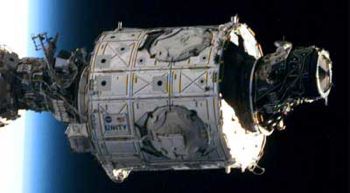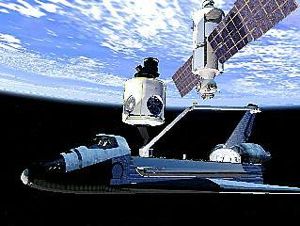
Home - Search - Browse - Alphabetic Index: 0- 1- 2- 3- 4- 5- 6- 7- 8- 9
A- B- C- D- E- F- G- H- I- J- K- L- M- N- O- P- Q- R- S- T- U- V- W- X- Y- Z
ISS Unity
AKA: Unity. Status: Operational 1998. First Launch: 1998-12-04. Last Launch: 1998-12-04. Number: 1 . Gross mass: 11,600 kg (25,500 lb). Height: 11.00 m (36.00 ft). Span: 4.00 m (13.10 ft).
It consisted of a six-sided connecting module and passageway, and was the primary cargo of Space Shuttle mission STS-88, the first mission dedicated to assembly of the station.
The Unity connecting module, technically referred to as node 1, would lay a foundation for all future U.S. International Space Station modules with six berthing ports, one on each side, to which future modules would be attached. Built by The Boeing Company at a manufacturing facility at the Marshall Space Flight Center in Huntsville, Alabama, Unity was the first of three such connecting modules that would be built for the station. Sometimes referred to as Node 1, the Unity module measured 15 feet in diameter and 18 feet long.
Meeting in Space
Carried to orbit aboard the Space Shuttle Endeavour, Unity would be mated with the already orbiting Zarya control module, or Functional Cargo Block (Russian acronym FGB), a U.S.-funded and Russian-built component that would had been launched earlier aboard a Russian rocket from Kazakhstan. In addition to connecting to the Zarya module, Unity eventually would provide attachment points for the U.S. laboratory module; Node 3; an early exterior framework, or truss for the station; an airlock; and a multi-windowed cupola.
Vital Resources
Essential space station resources such as fluids, environmental control and life support systems, electrical and data systems were routed through Unity to supply work and living areas.
More than 50,000 mechanical items, 216 lines to carry fluids and gases, and 121 internal and external electrical cables using six miles of wire were installed in the Unity node. The detailed and complex hardware installation required more than 1,800 drawings. The node was made of aluminum.
Pressurized Mating Adapters
Two conical docking adapters would be attached to each end of Unity prior to its launch aboard Endeavour. The adapters, called pressurized mating adapters (PMAs), allow the docking systems used by the Space Shuttle and by Russian modules to attach to the node's hatches and berthing mechanisms. One of the conical adapters would attach Unity to the Zarya, while the other would serve as a docking port for the Space Shuttle. The Unity node with the two mating adapters attached, the configuration it would be in for launch, was about 36 feet long and weighs about 25,600 pounds.
Attached to the exterior of one of the pressurized mating adapters were computers, or multiplexer-demultiplexers (MDMs), which would provide early command and control of the Unity node. Unity also would be outfitted with an early communications system that would allow data, voice and low data rate video with Mission Control, Houston, to supplement Russian communications systems during the early station assembly activities.
More at: ISS Unity.
Family: Space station, Space station orbit, USA - Space Stations. Country: USA. Spacecraft: ISS. Launch Vehicles: Space Shuttle. Launch Sites: Cape Canaveral, Cape Canaveral LC39A. Agency: NASA, Boeing. Bibliography: 2, 3513.
 | Unity Credit: Manufacturer Image |
1998 December 4 - . 08:35 GMT - . Launch Site: Cape Canaveral. Launch Complex: Cape Canaveral LC39A. Launch Platform: MLP3. LV Family: Shuttle. Launch Vehicle: Space Shuttle.
- Unity - . Mass: 11,600 kg (25,500 lb). Nation: USA. Agency: NASA Houston. Manufacturer: Douglas. Program: ISS. Class: Manned. Type: Manned space station. Spacecraft Bus: ISS. Spacecraft: ISS Unity. Decay Date: 1972-01-01 . USAF Sat Cat: 25575 . COSPAR: 1998-069F. Apogee: 400 km (240 mi). Perigee: 387 km (240 mi). Inclination: 51.50 deg. Period: 92.43 min.
Back to top of page
Home - Search - Browse - Alphabetic Index: 0- 1- 2- 3- 4- 5- 6- 7- 8- 9
A- B- C- D- E- F- G- H- I- J- K- L- M- N- O- P- Q- R- S- T- U- V- W- X- Y- Z
© 1997-2019 Mark Wade - Contact
© / Conditions for Use
